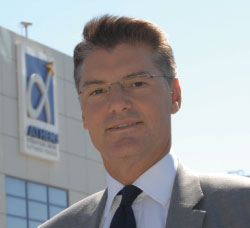
Paraschis: “Speaking as ACI EUROPE President, we have a good relationship with our peers from European airlines. Security, safety and the environment are common challenges for us, and ensuring the competitiveness of the aviation industry is jointly a short-to-medium term challenge. It is a situation in which we need to adjust and jointly face challenges.”
Athens International Airport enjoyed record traffic figures in 2007, with throughput reaching 16.5 million – up 10% on 2006; it was a year in which it achieved excellent performance in all sectors. The impact of the international economic crisis has meant a slowdown at AIA, as across Europe, in the first eight months of 2008.
“Oil is trading at US$80 a barrel – down from a peak of US$146 in the mid-summer, which I needn’t tell you is a positive development for aviation. However, the wider economic circumstances will remain critical for a year to 18 months at least. It is a situation in which we need to adjust,” said Paraschis. “Airports are businesses and they have to cope with the new economic order as well.”
He firmly believes that in the long-term aviation is a sector that is positive for the development of society. Indeed, he contends that if aviation growth were to be curbed, that would be a failure to society. “Airports are planning and investing with a view to the long-term. The situation with airlines is more short / medium term oriented. Speaking as ACI EUROPE President, we have a good relationship with our peers from European airlines. Security, safety and the environment are common challenges for us, and ensuring the competitiveness of the aviation industry is jointly a short-to-medium term challenge. It is a situation in which we need to adjust and jointly face challenges,” said Paraschis.
Aviation has weathered many crises in the past – the first Gulf War, 9/11 – while the liberalisation process and the introduction of the LCC business model in Europe has helped streamline the industry. “In the wake of the exceptionally high oil prices and the impact of the credit crisis on passenger traffic, a period of airline consolidation is occurring. However, aviation will remain a growth industry and the airport capacity crunch facing European airports is not only a genuine threat to the sector, but consequently, to the economic and social well-being,” said Paraschis. “Comparatively speaking, Europe is the most difficult place internationally to get permits for infrastructural expansion, a factor which only serves to heighten the urgency of the capacity crunch.”
EUROCONTROL is set to release the main findings of its revised ‘Challenges to Growth’ report at ACI EUROPE’s Airport Exchange event in Berlin. Shortly after, the EU Observatory on Airport Capacity will have its first meeting in early November. “I am hopeful that both developments will bring more visibility to this issue and the need to deal with it – it would be a mistake to place excuses for not dealing with the capacity crunch on the present crisis,” said Paraschis.
‘Harmonisation and a level playing field’
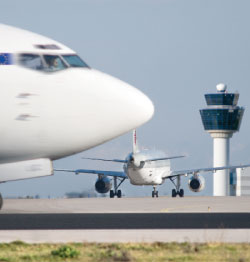
“We are recognised by the airlines for our efforts to support them. In the last four years we have been honoured with the OAG Award for our route development, strategy and airline marketing support. Our business model is an aggressive marketing model,” said Paraschis.
Paraschis expressed his honour at being ACI EUROPE President for more than a year; he has been involved with the organisation for a decade. “The goal has always been to be the common voice for Europe’s airports. The organisation needs to have an importance and a gravitas – and I think that we have adapted to new challenges over time and considerably widened the scope of the issues that we deal with. ACI EUROPE was established to represent its members on a European level in a way that individual airports cannot do,” he said.
He called for harmonisation in terms of legislation; given the regulations in Member States, the principle, said Paraschis, should be “as little European regulation as possible and as much as absolutely necessary”. “As the EU gets bigger in terms of Member States there is more and more legislation at its level. Tangible recent examples are the expanding presence of EASA in safety, LAGs in security and the ETS (Emissions Trading Scheme) as regards the environment. The trend is towards centralisation of legislation. But, it is important that an appropriate level of flexibility is maintained. We need harmonisation with both flexibility and a level playing field for all,” he said.
ACI EUROPE has recognised the increasing importance of smaller airports with the establishment of the Small and Medium Size Airports Action Group (SMAG), which has a growing membership that currently stands at 138 airports. The Group has just partnered for the second time with the EU Committee of the Regions for the organisation of the Open Days’ event in Brussels and is active on several fronts including economic regulation, security and State aid. “This is an example of the tangible relevance and added value of ACI EUROPE; another is the issue of Airport Charges, on which we convinced the regulators that it doesn’t make sense to include airports with fewer than five million passengers per year,” said Paraschis.
Environmental responsibility
ACI EUROPE has taken the significant decision to develop a European-wide accreditation scheme allowing airports to work towards being carbon neutral. This follows a landmark resolution from its General Assembly, under which Europe’s airports have committed to reduce carbon emissions with the goal of becoming carbon neutral. “For airports, committing to carbon reduction with the ultimate goal of becoming carbon neutral is about looking to the future, setting a vision and continuing to earn their licence to grow,” said Paraschis. “Carbon reduction is based on a roadmap with a tangible methodology – airports in Europe have different scales and environmental challenges.”
As with others, carbon neutrality at AIA is the ultimate goal long-term, but there is no set timescale for achieving it.
Committed to the environment
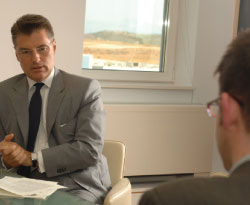
“We have been very cautious throughout the years and taken special measures in order to safeguard AIA’s financial position. Our strategy focuses on a balanced portfolio of airlines, enabling us not to be dependent on one carrier,” said Paraschis.
Closer to home, Paraschis is proud of the special emphasis that AIA places on environmental care. With a state-of-the-art Environmental Services department certified according to EN ISO 140001:2004, which implements an integrated environmental management system, AIA aims to operate responsibly towards the airport community and its neighbours, while at the same time undertaking initiatives on a wider scale. It has, to date, invested more than €40 million in a number of pioneering environmental projects and initiatives.
“Among our top priorities is the responsible and effective management of all environmental challenges; we are really committed to reducing our impact on climate change. Focusing on emissions under our direct control, we have already successfully implemented several measures,” said Paraschis.
These include the implementation of energy-saving measures regarding building lighting, ventilation, heating, etc, through participation in the European GreenLight and Greenbuilding programmes. The airport was awarded the GreenLight Award in 2004, for the implementation of a series of preventive maintenance activities and energy efficient measures in lighting, resulting in reducing emissions related to the greenhouse effect, and in 2008, the GreenBuilding Award acknowledged the energy saving performance of the airport’s facilities and buildings in the two previous years. In 2007, AIA reduced energy consumption by nearly 3,000 MWh, which corresponded to a decrease of approximately 2,800 tonnes of CO2.
Other measures include the installation and operation of pilot photovoltaics since 2004, and restrictions on the use of Auxiliary Power Units (APUs) by aircraft. “We are currently examining the possibilities of using alternative and renewable energy sources, such as photovoltaics, aiming at the development of an 8MW photovoltaic park – an investment rising to €50 million.
The focus in 2007 was on recycling and climate change. The airport has, since 2001, increased the amount of recyclables from 3% of total waste to 34% – that figure rose to 49% in Q1 2008.
The airport also established its focused Climate Change Corporate Action Plan (CCCAP) last year, which includes eight actions/initiatives for 2008, relating to the areas of airport operations, transportation, energy management and natural environment. “Further to the plan, total CO2 reduction is expected to exceed 3,000 tonnes. It is worth mentioning that the plan will contribute to the reduction of all pollutants, thus contributing to the improvement of air quality even in the wider area outside the airport. We are in the process of, and shall keep investigating, more future initiatives, aiming to contribute to the reduction of greenhouse gas emissions,” said Paraschis. “Dealing with environmental challenges responsibly and efficiently, is a serious priority for Athens International Airport. Our company’s environmental action and initiatives will continue, based on the principle that environmental protection is a prerequisite for the continuous development of the airport and the harmonious co-existence with the local communities.”
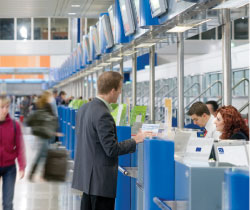
The domestic services of Olympic Airlines and Aegean Airlines account for 36% of AIA’s traffic. AIA works closely with both the airlines and the Athens tourist board to develop synergies and collaborate on the branding of Athens as a destination.
Traffic Mix
AIA has faced the issue of Olympic Airways’ sustainability since its opening in 2001. “We have been very cautious throughout the years and taken special measures in order to safeguard AIA’s financial position. Our strategy focuses on a balanced portfolio of airlines, enabling us not to be dependent on one carrier,” said Paraschis. “Regarding the hub model, we would say that hubs are not made by airports but by airlines. Still, AIA is a natural hub for the domestic market, with its 20% representing traffic between international and domestic services.”
The main ingredients for hub potential are present at Athens – capacity and geographical position. Paraschis also considers the airport well-positioned for route development as a hub for cities in the Balkans, Eastern Europe, the Middle East, and Africa.
The domestic services of Olympic Airlines and Aegean Airlines account for 36% of AIA’s traffic. AIA works closely with both the airlines and the Athens tourist board to develop synergies and collaborate on the branding of Athens as a destination.
“We are recognised by the airlines for our efforts to support them. In the last four years we have been honoured with the OAG Award for our route development strategy and airline marketing support,” said Paraschis. “Our business model is an aggressive marketing model. Our target is to grow profitably and stronger than average. We are definitely aiming to grow the network and at the same time are trying to support Athens as a destination. Athens has been relaunched as a destination through the 2004 Olympic Games.”

“Whereas the aviation business grows generally in line with the macroeconomy, we are looking continuously for opportunities to outperform the macroeconomic trends,” said Paraschis, “increasingly focusing on commercial revenues, an integral part of AIA’s strategy and a key contributor to its profitability.”
Marketing & Branding
AIA has, since opening, implemented a focused strategy to attract low-cost carriers (LCCs). Thanks to this approach, it has enjoyed notably good development in the sector; it now has 15 LCCs serving around 30 routes. “Always focusing on route development, we have been following very closely the developing products offered by traditional carriers and LCCs and seen the changes and the phases of maturity they have gone through. Rather than a dedicated product, we have chosen to adjust to developing requirements, offering innovative services to passengers – focusing on their needs and trends as well as on the cost effectiveness for airlines,” said Paraschis.
The consistent strategy has, naturally, been to increase the number of routes, airlines and frequencies out of the airport. As a result, AIA welcomed 17 new airlines in 2007 and 33 new airlines, 27 new destinations and numerous additional frequencies since it’s opening in 2001. “In fact, we have chosen to invest considerably in airport marketing, and decided to take over this role; given a continuous success in this sector, we consider it to be one of AIA’s competitive advantages,” said Paraschis.
Furthermore, AIA’s logo re-launch and branding strategy have also yielded results – it recently won the Superbrand award in Greece, as the most acknowledged Greek brand, an impressive indication of how the airport can win over the hearts and minds of the public.
Commercial strategy
Whereas aviation business grows generally in line with the macroeconomy, we are looking continuously for opportunities to outperform the macroeconomic trends said Paraschis, increasingly focusing on commercial revenues, an integral part of AIA’s strategy and a key contributor to its profitability. Commercial activities account for 40% of total revenues; they are the main contributor to profitability and are responsible for 65% of profit before tax. “AIA continuously ranks among the airports with the highest passenger spending, offering high quality and value-for-money products to passengers. Following this positive development, we are increasing the commercial space available for terminal retail. In terms of real estate, we have achieved significant developments within our ‘airport city’ vision. Besides a very successful Retail Park, we are developing a new state-of-the-art Exhibition Centre that is expected to serve as another pole of attraction for passengers indirectly in the long run,” said Paraschis.
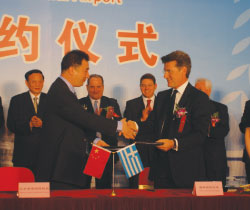
AIA and Beijing Capital International Airport (BCIA) signed a Brotherhood Agreement at a ceremony in the Chinese capital in July. It was signed by Dong Zhiyi, General Manager, BCIA, and Dr. Yiannis Paraschis, CEO, AIA and ACI EUROPE President.
AIA’s Exhibition Centre is expected to open in 2009, providing leading services in a 50,000sqm covered space. The completion of the project will mark the creation of a significant large-scale exhibition venue for the city of Athens, which is projected to significantly boost business travel volumes, as well as tourist traffic.
Another niche source of commercial revenues for AIA is the IT&T sector, in which AIA has expanded its activity internationally, having already provided services to several other international airports counting India, China, Australia and the Emirates as clients.
AIA is a fully-fledged commercial business – balancing the expectations of shareholders (Greek State 55%, Hochtief major private shareholder) and its public role – this public-private partnership works well, while also maintaining the necessary independence from the Greek state.
Athens-Beijing Brotherhood Agreement

AIA already enjoys natural hub status for domestic traffic; Paraschis also considers the airport well-positioned for route development as a hub for cities in the Balkans, Eastern Europe, the Middle East and Africa.
AIA and Beijing Capital International Airport (BCIA) signed a Brotherhood Agreement at a ceremony in the Chinese capital in July. It establishes a key link between the host cities of the two most recent Olympic Games. AIA received widespread praise for its performance during the 2004 Olympic Games and it shared experience and know-how with both the Beijing Organizing Committee for the Olympic Games and BCIA.
The pledge establishes liaisons of friendship and partnership, aiming to improve air connections between Beijing and Athens, exchange expertise in terms of airport management and technology, and cooperate in developmental projects around the world. “The common experience and unique endeavour for the Olympic Games have been a catalyst for the development of ties of friendship and partnership between our airports. We are delighted for this mutual commitment for the transfer of know-how and the joint engagement in international projects that will offer Beijing and Athens airports new development opportunities,” said Paraschis.
Air China launched services from Beijing to Athens, via Dubai, last November and Paraschis is hopeful that the frequency and number of carriers from AIA to China will be increased.







